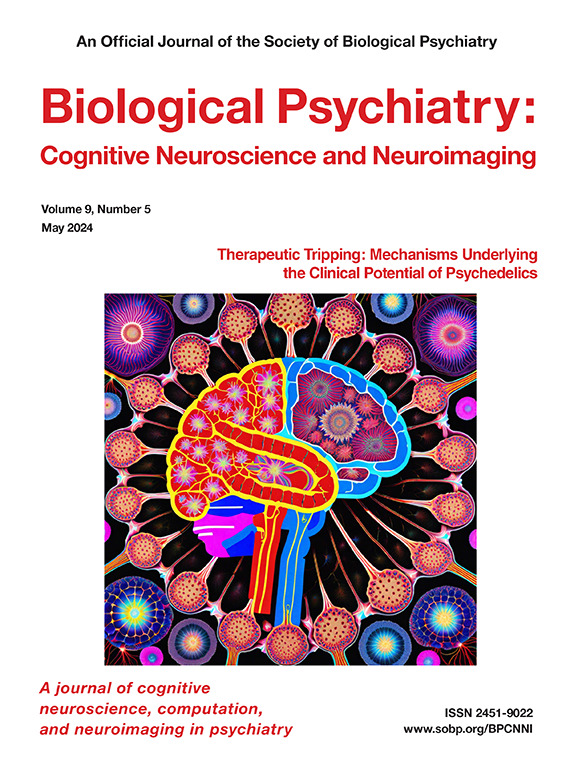Efficacy of Deep Brain Stimulation for Treatment-Resistant Depression: Systematic Review and Meta-Analysis
IF 5.7
2区 医学
Q1 NEUROSCIENCES
Biological Psychiatry-Cognitive Neuroscience and Neuroimaging
Pub Date : 2024-12-01
DOI:10.1016/j.bpsc.2024.08.013
引用次数: 0
Abstract
Background
Treatment-resistant depression affects about 30% of individuals with major depressive disorder. Deep brain stimulation is an investigational intervention for treatment-resistant depression with varied results. We undertook this meta-analysis to synthesize outcome data across trial designs, anatomical targets, and institutions to better establish efficacy and side-effect profiles.
Methods
We conducted a systematic PubMed review following Preferred Reporting Items for Systematic Reviews and Meta-Analyses (PRISMA) guidelines. Seven randomized controlled trials (n = 198) and 8 open-label trials (n = 77) were included spanning 2009 to 2020. Outcome measures included Hamilton Depression Rating Scale or Montgomery–Åsberg Depression Rating Scale scores, as well as response and remission rates over time. Outcomes were tracked at the last follow-up and quantified as a time course using model-based network meta-analysis. Linear mixed models were fit to individual patient data to identify covariates.
Results
Deep brain stimulation achieved 47% improvement in long-term depression scale scores, with an estimated time to reach 50% improvement of around 23 months. There were no significant subgroup effects of stimulation target, time of last follow-up, sex, age of disease onset, or duration of disease, but open-label trials showed significantly greater treatment effects than randomized controlled trials. Long-term (12–60 month) response and remission rates were 48% and 35%, respectively. The time course of improvement with active stimulation could not be adequately distinguished from that with sham stimulation, when available.
Conclusions
Deep brain stimulation produces significant chronic improvement in symptoms of treatment-resistant depression. However, the limited sham-controlled data do not demonstrate significant improvement over placebo. Future advancements in stimulation optimization and careful blinding and placebo schemes are important next steps for this therapy.
脑深部刺激治疗耐药性抑郁症的疗效:系统回顾和荟萃分析。
背景:约有 30% 的重度抑郁症患者会出现治疗耐受性抑郁症(TRD)。脑深部刺激(DBS)是一种针对TRD的研究性干预措施,其结果各不相同。我们进行了这项荟萃分析,以综合不同试验设计、解剖靶点和机构的结果数据,从而更好地确定疗效和副作用情况:我们按照 PRISMA 指南在 PubMed 上进行了系统性综述。共纳入 7 项随机对照试验(n=198)和 8 项开放标签试验(n=77),时间跨度为 2009-2020 年。结果测量包括汉密尔顿抑郁量表或蒙哥马利-奥斯伯格抑郁量表评分,以及随时间变化的反应率和缓解率。在最后一次随访时对结果进行跟踪,并使用基于模型的网络荟萃分析将结果量化为一个时间过程。线性混合模型适用于单个患者数据,以确定协变量:结果:DBS使长期抑郁量表评分提高了47%,估计达到50%的提高需要23个月左右。刺激目标、最后一次随访时间、性别、发病年龄或病程没有明显的亚组效应,但开放标签试验的治疗效果明显高于随机对照试验。长期(12-60 个月)反应率和缓解率分别为 48% 和 35%。在有假性刺激的情况下,活性刺激与假性刺激的改善时间过程无法充分区分:结论:DBS能显著改善TRD的慢性症状。结论:DBS 对 TRD 症状有明显的慢性改善作用,但有限的假性对照数据并未显示出与安慰剂相比有明显改善。未来在刺激优化、仔细盲法和安慰剂方案方面取得进展是该疗法下一步的重要工作。
本文章由计算机程序翻译,如有差异,请以英文原文为准。
求助全文
约1分钟内获得全文
求助全文
来源期刊

Biological Psychiatry-Cognitive Neuroscience and Neuroimaging
Neuroscience-Biological Psychiatry
CiteScore
10.40
自引率
1.70%
发文量
247
审稿时长
30 days
期刊介绍:
Biological Psychiatry: Cognitive Neuroscience and Neuroimaging is an official journal of the Society for Biological Psychiatry, whose purpose is to promote excellence in scientific research and education in fields that investigate the nature, causes, mechanisms, and treatments of disorders of thought, emotion, or behavior. In accord with this mission, this peer-reviewed, rapid-publication, international journal focuses on studies using the tools and constructs of cognitive neuroscience, including the full range of non-invasive neuroimaging and human extra- and intracranial physiological recording methodologies. It publishes both basic and clinical studies, including those that incorporate genetic data, pharmacological challenges, and computational modeling approaches. The journal publishes novel results of original research which represent an important new lead or significant impact on the field. Reviews and commentaries that focus on topics of current research and interest are also encouraged.
 求助内容:
求助内容: 应助结果提醒方式:
应助结果提醒方式:


